Hot Tips on Shipping Your Artwork
April 23, 2013
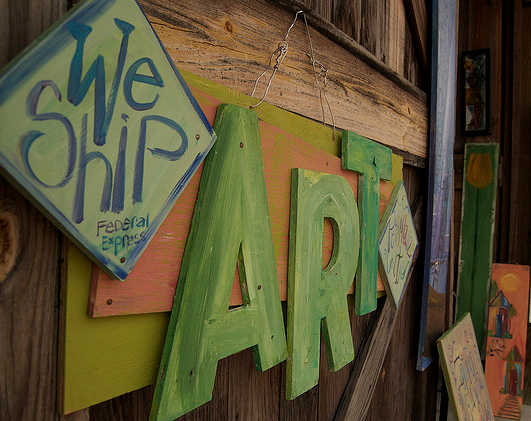 (As deadlines approach for shipping work to SDA in•ter•face Conference, NewsBlog asked Patricia Malarcher to assemble a list of helpful tips based on her experience. If you’re shipping work to San Antonio, exhibition coordinators will send you specific directions & deadlines. Thanks to former SDA Conference Manager Dot Moye for suggesting this article after the last conference. – NewsBlog Editor Leesa Hubbell )
(As deadlines approach for shipping work to SDA in•ter•face Conference, NewsBlog asked Patricia Malarcher to assemble a list of helpful tips based on her experience. If you’re shipping work to San Antonio, exhibition coordinators will send you specific directions & deadlines. Thanks to former SDA Conference Manager Dot Moye for suggesting this article after the last conference. – NewsBlog Editor Leesa Hubbell )
Is there an artist without a horror story related to shipping?
How about this one:
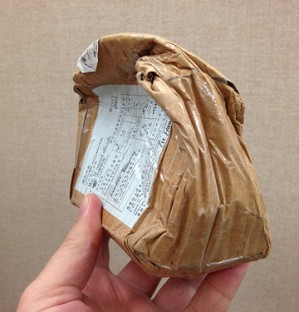 I was invited to exhibit in a quilt show in France. The deadline was close, but UPS assured me that a week was enough time to get the quilt to Texas, where the show would be assembled and sent overseas. I packed my piece in a reusable Sonotube, sent it off via UPS, and 2 days later, it was delivered—to my own front door!
I was invited to exhibit in a quilt show in France. The deadline was close, but UPS assured me that a week was enough time to get the quilt to Texas, where the show would be assembled and sent overseas. I packed my piece in a reusable Sonotube, sent it off via UPS, and 2 days later, it was delivered—to my own front door!
When the tube had been returned from a previous show, I’d neglected to remove the shipping label so that’s what was scanned at the dispatching center. Fortunately, I managed to curb my panic, and re-sent the package via FedEx’s overnight service.
The lesson learned—when re-using a box or container, remove or cover up any addresses or bar codes from previous use—came at a very high price.
COMPARISON OF SERVICES: FedEx / UPS / USPS
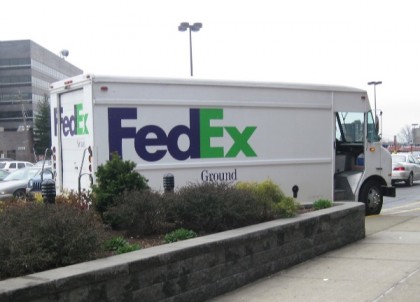 I use FedEx and UPS interchangeably. Both have guaranteed delivery schedules, and you can track packages in transit. (However you ship, keep the receipt with the tracking number handy.)
I use FedEx and UPS interchangeably. Both have guaranteed delivery schedules, and you can track packages in transit. (However you ship, keep the receipt with the tracking number handy.)
FedEx is never the cheaper route, but using FedEx Ground or FedEx Express/Third Day Delivery keeps the cost down. FedEx and UPS will pick up packages from your home or studio for a nominal fee in addition to the shipping cost. Otherwise, UPS Stores and FedEx Offices, where both packing and shipping services are available, are widely accessible.
 When you’re sending more than one piece in more than one container to the same address, FedEx will ship them all under one label rather than as separate items. (The barcode is the mother hen that keeps them together.) That ensures their arrival at the same time, and whoever accepts them will have only one form to sign. It also means that if your package is picked up at your address, there will be a fee for only one item. UPS requires a separate form for each piece.
When you’re sending more than one piece in more than one container to the same address, FedEx will ship them all under one label rather than as separate items. (The barcode is the mother hen that keeps them together.) That ensures their arrival at the same time, and whoever accepts them will have only one form to sign. It also means that if your package is picked up at your address, there will be a fee for only one item. UPS requires a separate form for each piece.
Go Small with USPS: For smallish packages, US Postal Service’s Priority Mail is the most economical route. USPS won’t guarantee arrival on a particular day—unlike FedEx and UPS, it doesn’t have its own fleet of planes—but you can track delivery.
INTERNATIONAL SERVICES:
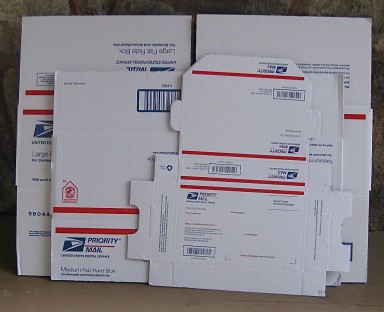 Both FedEx and UPS have international service. However, a FedEx representative advised contacting customer service about customs regulations that differ from one country to another. Rates became an issue when I was sending work to South Korea—the cost for the trip there and back via FedEx was close to the value of the piece being sent.
Both FedEx and UPS have international service. However, a FedEx representative advised contacting customer service about customs regulations that differ from one country to another. Rates became an issue when I was sending work to South Korea—the cost for the trip there and back via FedEx was close to the value of the piece being sent.
Chunghie Lee, a Korean artist who frequently ships internationally, recommended US Postal Service Express Mail International. I followed her advice, and found that service to be fast and reliable at a surprisingly reasonable price. Lee also said that using USPS rather than a commercial service avoided time-consuming paperwork at the receiving end.
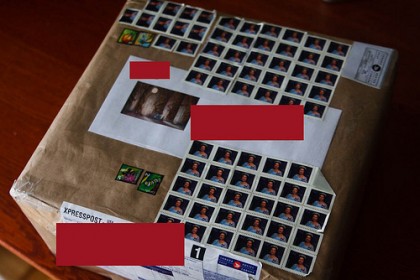 Go USPS for P.O. Boxes: Only USPS delivers to P.O. boxes. All other carriers require street addresses.
Go USPS for P.O. Boxes: Only USPS delivers to P.O. boxes. All other carriers require street addresses.
Shipping Myth or Hot Tip?: This may be apocryphal, but ’tis said that it’s best to ship during the middle of the week so your package doesn’t get sidetracked over a weekend.
When to Go Pro: For domestic and overseas shipping of artworks too large or complex to send via standard carriers, professional art handlers are the gold standard. FedEx offers a service for artworks called FedEx Custom Critical, but in most major cities there are specialized art shipping companies that pack, crate, transport, and deliver artwork. A long list appears when you google art shipping services. You might also check with a local gallery for a referral.
PACKING MATERIALS
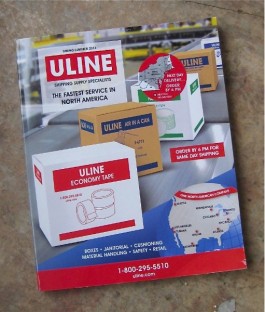 I no longer cruise around scavenging abandoned refrigerator cartons from which to make boxes, or haunt carpet dealers for discarded rug tubes. Now there are plenty of retail sources—notably, at UPS Stores, FedEx Offices, Staples and Home Depot—for boxes and tubes in a range of shapes and sizes.
I no longer cruise around scavenging abandoned refrigerator cartons from which to make boxes, or haunt carpet dealers for discarded rug tubes. Now there are plenty of retail sources—notably, at UPS Stores, FedEx Offices, Staples and Home Depot—for boxes and tubes in a range of shapes and sizes.
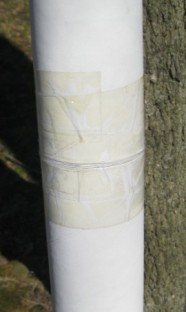 If you have space to store boxes in quantities, check an online source such as Uline.com, for an enormous selection at excellent prices. USPS Post offices carry a variety of free boxes for use with Priority Mail, and sell a limited supply of others in larger sizes. They also sell 24- and 36-inch tubes (intended for shipping documents) that I use for rolling up large 2-D fabric pieces in preparation for packing in larger tubes or boxes. Sometimes I tape 2 of these tubes together, end to end, to get the right size. FedEx Office carries 48-inch tubes.
If you have space to store boxes in quantities, check an online source such as Uline.com, for an enormous selection at excellent prices. USPS Post offices carry a variety of free boxes for use with Priority Mail, and sell a limited supply of others in larger sizes. They also sell 24- and 36-inch tubes (intended for shipping documents) that I use for rolling up large 2-D fabric pieces in preparation for packing in larger tubes or boxes. Sometimes I tape 2 of these tubes together, end to end, to get the right size. FedEx Office carries 48-inch tubes.
 Sonotubes (tubular molds for casting concrete) are almost indestructible as shipping containers and are great for holding quilts that are rolled. Available at building supply stores, they come in different diameters (e.g., 8, 10, and 12 inches) and lengths; you may have to saw the ends off to get the length you need. Their open ends have to be covered, but you can make lids from corrugated sheets or other heavy cardboard.
Sonotubes (tubular molds for casting concrete) are almost indestructible as shipping containers and are great for holding quilts that are rolled. Available at building supply stores, they come in different diameters (e.g., 8, 10, and 12 inches) and lengths; you may have to saw the ends off to get the length you need. Their open ends have to be covered, but you can make lids from corrugated sheets or other heavy cardboard.
 Recently, I started shipping rolled quilts in ski boxes—2 long boxes that telescope into each other so the length is flexible and the walls are extra sturdy. Available at UPS Stores, these are normally strong enough to re-use. If you fold quilts or tapestries for shipping, rolling plastic dry cleaner bags and placing them in the folds can help prevent creases.
Recently, I started shipping rolled quilts in ski boxes—2 long boxes that telescope into each other so the length is flexible and the walls are extra sturdy. Available at UPS Stores, these are normally strong enough to re-use. If you fold quilts or tapestries for shipping, rolling plastic dry cleaner bags and placing them in the folds can help prevent creases.
To ship fragile items, DC-area artist Saaraliisa Ylitalo recommends double-boxing—one box inside another—to absorb pressure from the outside. Fill any open spaces inside the boxes so the work can’t shift about or move around.
Recycling is a virtuous practice, but never use a carton that has lost its rigidity—it can collapse and break open, damaging the contents. Assume that your box may travel under something heavier than itself.
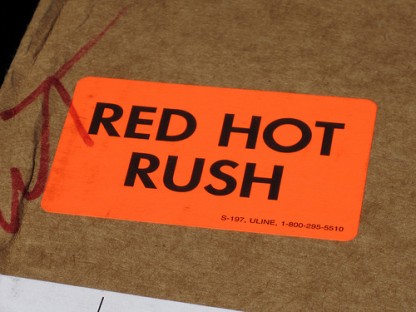 Wood crates are recommended for extremely heavy or hard-to-pack pieces, but be warned before building your own: wood used for international shipping must be provably sanitized to destroy any organisms therein.
Wood crates are recommended for extremely heavy or hard-to-pack pieces, but be warned before building your own: wood used for international shipping must be provably sanitized to destroy any organisms therein.
PRACTICE CLEAR LABELING: A final word about boxes: Mark the outside with information useful to those who will handle it. For example, if you want the box positioned or opened at a certain end, print “This End Up” or “Open Here” legibly and confirm with an arrow. “Fragile” stickers usually are available at shipping centers.
INSURANCE AND LOSS
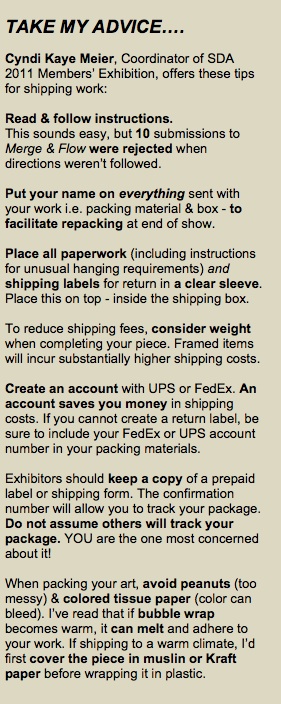 Most of the artists consulted for this article considered shipping artwork a calculated risk. We insure things – and then hope for the best.
Most of the artists consulted for this article considered shipping artwork a calculated risk. We insure things – and then hope for the best.
A FedEx clerk recently wanted to open a box for inspection because I’d valued the contents at $500. I didn’t want my careful packing disturbed – plus, there was nothing inside to validate worth – so I said “Cross out the value” and crossed my fingers. Like most packages, that one reached its destination, but inevitably some don’t, and disappear forever.
UPS insures art up to $50,000, while the ceiling for FedEx is only $1000, regardless of actual value.
We can claim whatever amount we want, but collecting insurance is reality-based.
All insurers require evidence to confirm the value of artwork beyond the cost of materials from which it was made. Claims are usually honored if a piece was sold and the artist has a receipt for the sale, or if the artwork had been appraised and documented by a certified professional.
In an unusual case, UPS fully reimbursed an artist whose package was lost en route to a gallery when she produced a copy of the itemized invoice listing prices for the contents, and stated that she could remake the artwork.
When USPS loses an uninsured package, a customer can request a search. This may seem like an exercise in futility, but it’s advisable to follow through (and then forget about it). With faint hope I filed a claim on a lost package of un-duplicatable photographs; they showed up a year later at a dead mail recovery center.
 The following websites give further information on most aspects of shipping, with the option of direct e-mail communication. Responses to questions come promptly.
The following websites give further information on most aspects of shipping, with the option of direct e-mail communication. Responses to questions come promptly.
UPS: www.international.ups.com/global-trade/international-shipping-guide
FedEx: www.fedex.com/us/international/easy-shipping-rates
USPS: www.usps.com/ship
(Editor’s Note: Surface Design Association Members Only Group on Facebook has attracted informative discussions about shipping – especially international practices. If you are an SDA member, request to join the discussion at the top of that Facebook page, searchable via “Surface Design Association (Members Only Group)”. Then scroll through the recent posts to find the discussions. Click on Facebook icon at the top of this page to start the process.)
_____________________________________________
 Patricia Malarcher is a studio artist and independent writer who was Editor of SDA’s quarterly Surface Design Journal for 18 years (1993-2011). She lives and works in Englewood, New Jersey.
Patricia Malarcher is a studio artist and independent writer who was Editor of SDA’s quarterly Surface Design Journal for 18 years (1993-2011). She lives and works in Englewood, New Jersey.

17 Comments
arlee barr says
April 24, 2013 at 8:56 am
Very useful--could we have some info too on declarations of value for customs purposes? How do we ensure customs does not charge for return of our own work when the value stated is above a certain amount, and also how do we label packages for that? IE gift, sample, document, etc? I'm quite concerned about this for the 12x12 member show as i am shipping from Canada.
karin millson says
April 24, 2013 at 9:02 am
Take care that your item doesn't include any non-acceptable materials eg., bird feathers. Or dirt/earth/soil. As some countries will want to charge you for irradiating the latter or simply wont accept import of the first.
saberah malik says
May 10, 2013 at 6:27 am
Last year I shipped art work to Portugal and to Turkey. Made many errors and in the arduous process, matured about shipping at tremendous emotional and financial pressure and cost. Delighted with this review on shipping tips, as my queries to all my professional Fiber groups at the time did not yield any advice or answers when I had really needed them. To all out there, use this article for every word is a valid testimony to both the pitfalls and for informed transactions and peace of mind.
Judy Topkis says
May 11, 2013 at 11:50 am
Excellent information.. How rates, regulations have changed and will continue to do so. For the time being, keep these suggestions handy and follow closely. Thank you for this timely article.
Linda Wallace says
May 11, 2013 at 5:34 pm
Arlee - for Canadians shipping work internationally, the best way to ensure easy re-entry back into Canada is to obtain a Temporary Export Permit from Canada Customs (or whatever they're calling themselves these days). They want to know the work is identifiably yours and that you aren't shipping in another work, under the same paperwork, that is more valuable. So - initials imbedded in the work, labelling, copies of any photos that identify it as yours. I always take the piece with me, and a photo of the piece - any other documentation you can provide them with will speed the ease of them filing in forms, stamping, signing. With regard to declaring a value at the border - what I have been told is that, as an individual, you are permitted broker your own work if it's valued at less than 2,000. Over that amount, and you are supposed to use a broker (and, pay a fee). I've crossed the border, to ship work in the USA, many times and have rarely been hassled. Again, lots of documentation. The US Customs want to be sure you're not a professional artist, shipping work to a gallery where it will be offered for sale - and, not properly importing the work as that of a business. Complicated, but it sure pays to do your level best to have all the possible documentation people with authority (and power...and, guns) might ever ask you for.
Linda Friedman Schmidt says
April 8, 2014 at 9:55 am
FedEx International Shipping prices are based on the dimensions of the container only, not the weight. Use the smallest container that your work will fit into to get the best deal.
Linda Friedman Schmidt says
May 9, 2014 at 1:17 pm
If you’re shipping within the 27 member countries of the EU your packages will not be subject to duties or taxes. Shipping to the EU also requires declaration forms CN22 or CN23. If your order value is less than € 22 (about $30 US Dollars), your buyer will not be charged any additional costs. If your order value is between € 22 and € 150, the import VAT will apply. For orders greater than € 150 your buyer will need to pay both VAT and customs duties. Addressing your packages Remember, the address formats of your buyers may vary based on location. It’s never a bad thing to check the common address formats for the location you’re shipping to , and format the address accordingly:http://www.upu.int/en/activities/addressing/postal-addressing-systems-in-member-countries.html Although you may be limited in placement and room on your customs forms, you might also consider displaying this information elsewhere on your package. If your buyer supplied an address with non-latin characters, it’s always a good idea to include a version of the address in the language of the origin location and the destination location.
Denise says
May 31, 2014 at 11:22 am
Great information. Thank you!
Trevette Jones-Dolan says
July 31, 2015 at 11:46 am
Have you ever considered hiring a shipping logistics company that will also insure your packages? Your personal logistics agent will watch your delivery from pickup to delivery. If you want more Info contact me for all your shipping details
Cheryl Smith says
November 30, 2015 at 6:03 pm
I like your advice on sawing the ends of the mailing tube to get to the right size. I usually just pack the extra lengths with newspaper. I will have to try this. Hopefully, it will help better protect what I'm shipping.
James Bergman says
March 23, 2016 at 9:48 am
I think picking the shipping material is the easiest step. However, I don't think I have ever used sonotubes. But if they are strong enough for concrete then they will probably do the job. Of course most mailing tubes are also pretty heavy duty, Anyway, thanks for the heads up on using sonotubes.
Becca Holton says
February 26, 2018 at 10:59 pm
I wouldn't have thought about using ski boxes to ship quilts. That's a genius idea, especially since you can use them again. I'm made a quilt for a friend and thought I would have to wait until I visit her again.
Taylor Bishop says
February 27, 2018 at 3:43 pm
I just wanted to thank you for these tips for shipping artwork. I'm glad you explained that there are a lot of retail sources that have boxes and tubes that come in a lot of different sizes. I wonder if it could be beneficial to research these different sizes beforehand so that you know if you need some other kind of packaging in there to help protect the art.
coresjpt says
March 9, 2018 at 4:04 am
Thanks for sharing these tips. Very Helpful.
Nick says
March 26, 2018 at 5:28 am
HI coresjpt, This was a excellent informative post you write on this page about the shipment of products and money door to door easily with in a required period of a time in a cheap delivery charges without any country tax ,if you want to received a product quickly with in a very cheap delivery charges then the best solution is you try Proprepandfulfillment product deviled services which is help full for you to solve the problem of receiving product quickly through shipment with in a cheap delivery charges and also give you a product shipment tracking code for your information about the delivery status of your product with the quick email and fast reply,My opinion is you try this great service comming in all over the word today and also save money on shpiping . Thanks.
Just Paper Tubes Ltd says
April 12, 2018 at 2:17 am
Great information!!! Thanks for sharing this great blog. I really got the best information Mailing Tubes from your blog. Keep it up…
Emily Bennette says
December 30, 2020 at 2:59 pm
I liked that you pointed out that you will want to consider rising good shipping material. Flat rate boxes do seem like they are pretty sturdy. It might also be smart to look into getting a shipping container if the artwork is really large and needs to go a long way. After all, I know that I would hate for a piece to show up to the client busted.
Related Blog Articles
Resources
Friday Fibers Roundup: Entertainment & Fashion
Resources
Friday Fibers Roundup: Craft & Color
Resources
Friday Fibers Roundup: Crochet + Color